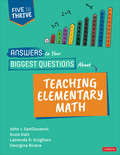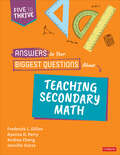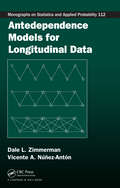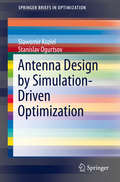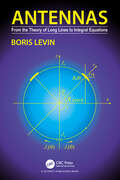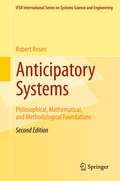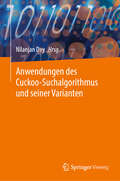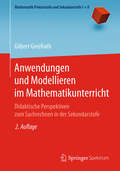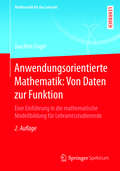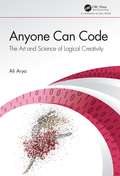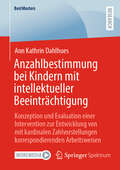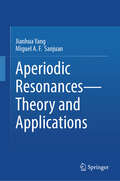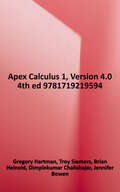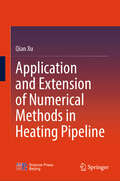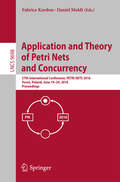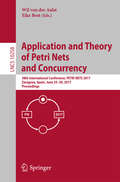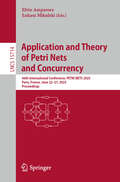- Table View
- List View
Answers to Your Biggest Questions About Teaching Elementary Math: Five to Thrive [series] (Corwin Mathematics Series)
by John J. SanGiovanni Susie Katt Latrenda Duretta Knighten Georgina RiveraYour guide to grow and learn as a math teacher! Let’s face it, teaching elementary math can be hard. So much about how we teach math today may look and feel different from how we learned it. Today, we recognize placing the student at the center of their learning increases engagement, motivation, and academic achievement soars. Teaching math in a student-centered way changes the role of the teacher from one who traditionally “delivers knowledge” to one who fosters thinking. Most importantly, we must ensure our practice gives each and every student the opportunity to learn, grow, and achieve at high levels, while providing opportunities to develop their agency and authority in the classroom which results in a positive math identity. Whether you are a brand new teacher or a veteran, if you find teaching math to be quite the challenge, this is the guide you want by your side. Designed for just-in-time learning and support, this practical resource gives you brief, actionable answers to your most pressing questions about teaching elementary math. Written by four experienced math educators representing diverse experiences, these authors offer the practical advice they wish they received years ago, from lessons they′ve learned over decades of practice, research, coaching, and through collaborating with teams, teachers and colleagues—especially new teachers—every day. Questions and answers are organized into five areas of effort that will help you most thrive in your elementary math classroom: 1. How do I build a positive math community? 2. How do I structure, organize, and manage my math class? 3. How do I engage my students in math? 4. How do I help my students talk about math? 5. How do I know what my students know and move them forward? Woven throughout, you′ll find helpful sidebar notes on fostering identity and agency; access and equity; teaching in different settings; and invaluable resources for deeper learning. The final question—Where do I go from here?— offers guidance for growing your practice over time. Strive to become the best math educator you can be; your students are counting on it! What will be your first step on the journey?
Answers to Your Biggest Questions About Teaching Elementary Math: Five to Thrive [series] (Corwin Mathematics Series)
by John J. SanGiovanni Susie Katt Latrenda Duretta Knighten Georgina RiveraYour guide to grow and learn as a math teacher! Let’s face it, teaching elementary math can be hard. So much about how we teach math today may look and feel different from how we learned it. Today, we recognize placing the student at the center of their learning increases engagement, motivation, and academic achievement soars. Teaching math in a student-centered way changes the role of the teacher from one who traditionally “delivers knowledge” to one who fosters thinking. Most importantly, we must ensure our practice gives each and every student the opportunity to learn, grow, and achieve at high levels, while providing opportunities to develop their agency and authority in the classroom which results in a positive math identity. Whether you are a brand new teacher or a veteran, if you find teaching math to be quite the challenge, this is the guide you want by your side. Designed for just-in-time learning and support, this practical resource gives you brief, actionable answers to your most pressing questions about teaching elementary math. Written by four experienced math educators representing diverse experiences, these authors offer the practical advice they wish they received years ago, from lessons they′ve learned over decades of practice, research, coaching, and through collaborating with teams, teachers and colleagues—especially new teachers—every day. Questions and answers are organized into five areas of effort that will help you most thrive in your elementary math classroom: 1. How do I build a positive math community? 2. How do I structure, organize, and manage my math class? 3. How do I engage my students in math? 4. How do I help my students talk about math? 5. How do I know what my students know and move them forward? Woven throughout, you′ll find helpful sidebar notes on fostering identity and agency; access and equity; teaching in different settings; and invaluable resources for deeper learning. The final question—Where do I go from here?— offers guidance for growing your practice over time. Strive to become the best math educator you can be; your students are counting on it! What will be your first step on the journey?
Answers to Your Biggest Questions About Teaching Secondary Math: Five to Thrive [series] (Corwin Mathematics Series)
by Frederick L. Dillon Ayanna D. Perry Andrea Negrete Cheng Jennifer OutzsLet’s face it, teaching secondary math can be hard. So much about how we teach math today may look and feel different from how we learned it. Teaching math in a student-centered way changes the role of the teacher from one who traditionally "delivers knowledge" to one who fosters thinking. Most importantly, we must ensure our practice gives each and every student the opportunity to learn, grow, and achieve at high levels, while providing opportunities to develop their agency and authority in the classroom which results in a positive math identity. Whether you are a brand new teacher or a veteran, if you find teaching math to be quite the challenge, this is the guide you want by your side. Designed for just-in-time learning and support, this practical resource gives you brief, actionable answers to your most pressing questions about teaching secondary math. Written by four experienced math educators representing diverse experiences, these authors offer the practical advice they wish they received years ago, from lessons they′ve learned over decades of practice, research, coaching, and through collaborating with teams, teachers and colleagues—especially new teachers—every day. Questions and answers are organized into five areas of effort that will help you most thrive in your secondary math classroom: How do I build a positive math community? How do I structure, organize, and manage my math class? How do I engage my students in math? How do I help my students talk about math? How do I know what my students know and move them forward? Woven throughout, you′ll find helpful sidebar notes on fostering identity and agency; access and equity; teaching in different settings; and invaluable resources for deeper learning. The final question—Where do I go from here?— offers guidance for growing your practice over time. Strive to become the best math educator you can be; your students are counting on it! What will be your first step on the journey?
Answers to Your Biggest Questions About Teaching Secondary Math: Five to Thrive [series] (Corwin Mathematics Series)
by Frederick L. Dillon Ayanna D. Perry Andrea Negrete Cheng Jennifer OutzsLet’s face it, teaching secondary math can be hard. So much about how we teach math today may look and feel different from how we learned it. Teaching math in a student-centered way changes the role of the teacher from one who traditionally "delivers knowledge" to one who fosters thinking. Most importantly, we must ensure our practice gives each and every student the opportunity to learn, grow, and achieve at high levels, while providing opportunities to develop their agency and authority in the classroom which results in a positive math identity. Whether you are a brand new teacher or a veteran, if you find teaching math to be quite the challenge, this is the guide you want by your side. Designed for just-in-time learning and support, this practical resource gives you brief, actionable answers to your most pressing questions about teaching secondary math. Written by four experienced math educators representing diverse experiences, these authors offer the practical advice they wish they received years ago, from lessons they′ve learned over decades of practice, research, coaching, and through collaborating with teams, teachers and colleagues—especially new teachers—every day. Questions and answers are organized into five areas of effort that will help you most thrive in your secondary math classroom: How do I build a positive math community? How do I structure, organize, and manage my math class? How do I engage my students in math? How do I help my students talk about math? How do I know what my students know and move them forward? Woven throughout, you′ll find helpful sidebar notes on fostering identity and agency; access and equity; teaching in different settings; and invaluable resources for deeper learning. The final question—Where do I go from here?— offers guidance for growing your practice over time. Strive to become the best math educator you can be; your students are counting on it! What will be your first step on the journey?
Antedependence Models for Longitudinal Data (Chapman & Hall/CRC Monographs on Statistics and Applied Probability)
by Dale L. Zimmerman Vicente A. Núñez-AntónThe First Book Dedicated to This Class of Longitudinal ModelsAlthough antedependence models are particularly useful for modeling longitudinal data that exhibit serial correlation, few books adequately cover these models. By gathering results scattered throughout the literature, Antedependence Models for Longitudinal Data offers a convenient, system
Antenna Design by Simulation-Driven Optimization (SpringerBriefs in Optimization)
by Slawomir Koziel Stanislav OgurtsovThis Brief reviews a number of techniques exploiting the surrogate-based optimization concept and variable-fidelity EM simulations for efficient optimization of antenna structures. The introduction of each method is illustrated with examples of antenna design. The authors demonstrate the ways in which practitioners can obtain an optimized antenna design at the computational cost corresponding to a few high-fidelity EM simulations of the antenna structure. There is also a discussion of the selection of antenna model fidelity and its influence on performance of the surrogate-based design process. This volume is suitable for electrical engineers in academia as well as industry, antenna designers and engineers dealing with computationally-expensive design problems.
Antennas: From the Theory of Long Lines to Integral Equations
by Boris LevinThis book describes both known and new results. In the sections devoted to the use of integral equations for the current in a linear metal radiator, the focus is on Leontovich's equation. An advantage of this equation is the simplicity of the solution and the absence of the argument φ in it because the integration over φ already performed. The refined solution makes it possible to determine the total sum of the series for the current, which is close to the known solution including only the first terms. The results of the synthesis of different types of antennas with capacitive loads are presented, which makes it possible to implement Hallen's hypothesis about the usefulness of applying such loads to create an in-phase current distribution in antennas and to obtain required characteristics.New results include the widespread use of the complex potential method in relation to the calculation of capacitive structures in homogeneous and inhomogeneous media, antenna patterns and flows of electrical fields between antenna elements and in the surrounding space. In particular, the analysis of field flows makes it possible to substantiate a rigorous method for analyzing microstrip antennas. The characteristics of antennas in various conditions of their installation are considered and compared. The results of the use of multi-floors structures that provide in the wide frequency range the radiation in direction perpendicular to the antenna axis, and structures that make it possible to reduce the mutual influence of antennas located at different heights on a common mast are described.
Anti-Differentiation and the Calculation of Feynman Amplitudes (Texts & Monographs in Symbolic Computation)
by Carsten Schneider Johannes BlümleinThis volume comprises review papers presented at the Conference on Antidifferentiation and the Calculation of Feynman Amplitudes, held in Zeuthen, Germany, in October 2020, and a few additional invited reviews. The book aims at comprehensive surveys and new innovative results of the analytic integration methods of Feynman integrals in quantum field theory. These methods are closely related to the field of special functions and their function spaces, the theory of differential equations and summation theory. Almost all of these algorithms have a strong basis in computer algebra. The solution of the corresponding problems are connected to the analytic management of large data in the range of Giga- to Terabytes. The methods are widely applicable to quite a series of other branches of mathematics and theoretical physics.
Anticipatory Systems: Philosophical, Mathematical, and Methodological Foundations (IFSR International Series in Systems Science and Systems Engineering #1)
by Robert RosenRobert Rosen was not only a biologist, he was also a brilliant mathematician whose extraordinary contributions to theoretical biology were tremendous. Founding, with this book, the area of Anticipatory Systems Theory is a remarkable outcome of his work in theoretical biology. This second edition of his book Anticipatory Systems, has been carefully revised and edited, and includes an Introduction by Judith Rosen. It has also been expanded with a set of Prolegomena by Dr. Mihai Nadin, who offers an historical survey of this fast growing field since the original work was published. There is also some exciting new work, in the form of an additional chapter on the Ontology of Anticipation, by Dr. John Kineman. An addendum-- with autobiographical reminiscences by Robert Rosen, himself, and a short story by Judith Rosen about her father-- adds a personal touch. This work, now available again, serves as the guiding foundations for the growing field of Anticipatory Systems and, indeed, any area of science that deals with living organisms in some way, including the study of Life and Mind. It will also be of interest to graduate students and researchers in the field of Systems Science.
Ants Rule: The Long and Short of It
by Bob BarnerMite-size engineers construct the perfect roller coaster in this fun-filled introduction to measurement and data presentation.The ants need to plan the Blowout Bug Jamboree! But how can they build a roller coaster for the festival if they don't know how many bugs will come, or how big those bugs will be? This enjoyable introduction to measurement, comparison, and data visualization focuses on building math skills that aren't dependent on units-- so it works equally well for young readers used to inches or centimeters. And most of all-- it's fun! Colorful cut-paper art brings the bugs-- and their creations-- to life. In a deluxe fold-out spread, everything comes together in a huge, perfect rollercoaster-- big enough for all the bugs at the Jamboree to enjoy, and filled with tiny details for clever readers to spot!
Anwendungen des Cuckoo-Suchalgorithmus und seiner Varianten
by Nilanjan DeyDieses Buch betont die grundlegenden Konzepte des CS-Algorithmus und seiner Varianten sowie deren Anwendung zur Lösung unterschiedlicher Optimierungsprobleme in medizinischen und ingenieurwissenschaftlichen Anwendungen. Evolutionäre metaheuristische Ansätze werden zunehmend zur Lösung komplexer Optimierungsprobleme in verschiedenen realen Anwendungen eingesetzt. Einer der erfolgreichsten Optimierungsalgorithmen ist die Cuckoo-Suche (CS), die zu einem aktiven Forschungsbereich geworden ist, um N-dimensionale und lineare/nichtlineare Optimierungsprobleme mithilfe einfacher mathematischer Prozesse zu lösen. CS hat die Aufmerksamkeit verschiedener Forscher auf sich gezogen, was zur Entstehung zahlreicher Varianten des grundlegenden CS mit verbesserten Leistungsmerkmalen seit 2019 geführt hat.
Anwendungen und Modellieren im Mathematikunterricht: Didaktische Perspektiven zum Sachrechnen in der Sekundarstufe (Mathematik Primarstufe und Sekundarstufe I + II)
by Gilbert GreefrathDie in diesem Buch dargestellten Anwendungen prägen den aktuellen Mathematikunterricht der Sekundarstufe. Didaktische Perspektiven zum Sachrechnen und das mathematische Modellieren sind eine wichtige Grundlage für die Lehrerbildung. Auch die aktuellen Bildungsstandards stellen prozessbezogene Kompetenzen wie das Modellieren in den Vordergrund. In diesem Lehrbuch lernen Sie aktuelle Sichtweisen auf Anwendungen im Mathematikunterricht vor dem Hintergrund des Sachrechnens und des mathematischen Modellierens kennen. Besonders ausführlich werden die vielfältigen Aufgabentypen eines anwendungsorientierten Mathematikunterrichts dargestellt und klassifiziert. Hier erhalten Sie auch viele Anregungen für den Unterricht. Einige typische Unterrichtsinhalte zu Anwendungen in der Sekundarstufe wie Zuordnungen von Größen und der Einsatz digitaler Werkzeuge runden den Band ab. Das Buch wendet sich an Lehramtsstudierende, Referendarinnen und Referendare sowie Lehrkräfte mit Mathematik als Fach.
Anwendungsorientierte Mathematik: Eine Einführung in die mathematische Modellbildung für Lehramtsstudierende (Mathematik für das Lehramt)
by Joachim EngelGegenstand des vorliegenden Lehrbuches ist der Prozess des Anwendens von Mathematik. Im Mittelpunkt stehen dabei der Funktionsbegriff sowie mathematische Methoden zur Modellierung funktionaler Abh#65533;ngigkeiten zwischen zwei Gr#65533;#65533;en. Das Buch zeichnet sich durch folgende besondere Merkmale aus: Reale Daten als Grundlage f#65533;r viele Modellierungen als eine wichtige Voraussetzung f#65533;r einen authentischen und glaubw#65533;rdigen Unterricht an Hochschule und Schule. Einsatz von Technologie als Werkzeug zum Probleml#65533;sen und zur Illustrierung von Konzepten und Zusammenh#65533;ngen. Vernetzung verschiedener Inhalte der Mathematik wie Elementare Funktionenlehre, Analysis, Stochastik, Lineare Algebra,Numerik. Detaillierte Ableitungen von Ergebnissen sowie #65533;bungen und Fragen am Ende der einzelnen Kapitel mit teilweise ausgearbeiteten L#65533;sungen und mit L#65533;sungshinweisen helfen bei der Vertiefung des Stoffes.
Anyone Can Code: The Art and Science of Logical Creativity
by Ali Arya"Ali Arya guides you in a fantastic journey full of creativity in a coherent way that allows the traveler to learn and build up over the knowledge acquired in previous chapters until the reader accomplishes skills to develop solutions using programming." — Andrés A. Navarro Newball, Professor, Pontificia Universidad Javeriana, Cali, Colombia "An excellent book that teaches programming and software development the way it should be done: independent from a specific implementation language and focusing on the main principles that are fundamental and substantive to any kind of software production." — Marc Conrad, Principal Lecturer, University of Bedfordshire, Luton, UK Anyone Can Code: The Art and Science of Logical Creativity introduces computer programming as a way of problem-solving through logical thinking. It uses the notion of modularization as a central lens through which we can make sense of many software concepts. This book takes the reader through fundamental concepts in programming by illustrating them in three different and distinct languages: C/C++, Python, and Javascript. Key features: Focuses on problem-solving and algorithmic thinking instead of programming functions, syntax, and libraries Includes engaging examples, including video games and visual effects Provides exercises and reflective questions This book gives beginner and intermediate learners a strong understanding of what they are doing so that they can do it better and with any other tool or language that they may end up using later. Author Ali Arya is an Associate Professor in the School of Information Technology at Carleton University, Ottawa, Canada. He received his PhD in Computer Engineering from the University of British Columbia, Vancouver, Canada, in 2003. He has over 25 years of experience in professional and academic positions related to software development and information technology. He is passionate about computer programming that brings together logical and creative abilities.
Anzahlbestimmung bei Kindern mit intellektueller Beeinträchtigung: Konzeption und Evaluation einer Intervention zur Entwicklung von mit kardinalen Zahlvorstellungen korrespondierenden Arbeitsweisen (BestMasters)
by Ann Kathrin DahlhuesIm Rahmen des Forschungsprojektes wird der Frage nachgegangen, wie sich die Arbeitsweisen zur Anzahlbestimmung bei Kindern mit intellektueller Beeinträchtigung unter Berücksichtigung der kardinalen Zahlvorstellung während einer Förderung der Menge-Zahl-Zuordnung entwickeln. Dabei liegt der Fokus auf der Bestimmung strukturiert dargestellten Anzahlen innerhalb des Zwanzigerfeldes. Um diese Frage beantworten zu können, wurde eine Einzelfallstudie mit zwei Kindern des dritten Schulbesuchsjahres einer Förderschule mit dem Schwerpunkt geistige Entwicklung durchgeführt (ZR6 und ZR20). Die Studie umfasste eine Prä- und Post-Standortanalyse, Einzelfördereinheiten sowie Verlaufstestungen. Der Fokus der Fördereinheiten lag auf der Mengenwahrnehmung, dem Zählen und der Herstellung von Beziehungen zwischen den Zahlen unter Berücksichtigung des intermodalen Transfers. Es zeigt sich, dass die Kinder strukturiert dargestellte Anzahlen nicht mehr immer zählend beantworten, sondern überwiegend die direkte Anzahlnennung nutzen. Auch die Strukturen des Zwanzigerfeldes können immer mehr erkannt und genutzt werden. Dennoch gibt es sowohl Schwankungen in der Lösungshäufigkeit als auch in der Lösungsgeschwindigkeit.
Aperiodic Order: A Mathematical Invitation
by Michael Baake Uwe GrimmQuasicrystals are non-periodic solids that were discovered in 1982 by Dan Shechtman, Nobel Prize Laureate in Chemistry 2011. The underlying mathematics, known as the theory of aperiodic order, is the subject of this comprehensive multi-volume series. This first volume provides a graduate-level introduction to the many facets of this relatively new area of mathematics. Special attention is given to methods from algebra, discrete geometry and harmonic analysis, while the main focus is on topics motivated by physics and crystallography. In particular, the authors provide a systematic exposition of the mathematical theory of kinematic diffraction. Numerous illustrations and worked-out examples help the reader to bridge the gap between theory and application. The authors also point to more advanced topics to show how the theory interacts with other areas of pure and applied mathematics.
Aperiodic Order: Crystallography and Almost Periodicity (Encyclopedia of Mathematics and its Applications #166)
by Michael Baake Uwe GrimmQuasicrystals are non-periodic solids that were discovered in 1982 by Dan Shechtman, Nobel Prize Laureate in Chemistry 2011. The mathematics that underlies this discovery or that proceeded from it, known as the theory of Aperiodic Order, is the subject of this comprehensive multi-volume series. This second volume begins to develop the theory in more depth. A collection of leading experts, among them Robert V. Moody, cover various aspects of crystallography, generalising appropriately from the classical case to the setting of aperiodically ordered structures. A strong focus is placed upon almost periodicity, a central concept of crystallography that captures the coherent repetition of local motifs or patterns, and its close links to Fourier analysis. The book opens with a foreword by Jeffrey C. Lagarias on the wider mathematical perspective and closes with an epilogue on the emergence of quasicrystals, written by Peter Kramer, one of the founders of the field.
Aperiodic Resonances - Theory and Applications
by Miguel A. Sanjuan Jianhua YangThis book presents various types of aperiodic resonances in the form of a complete theoretical framework for the first time. It makes aperiodic resonance be a new disciplinary direction. In addition to the achievements in existing papers, the book proposes some new methods and discovers some new phenomena about different aperiodic resonances in nonlinear systems. The book includes theoretical analysis methods and their applications in three typical engineering backgrounds. It links theoretical researches on physical phenomena with different engineering problems. It aims to solve engineering problems from a new perspective based on aperiodic resonance theories.
Apex Calculus 1
by Gregory Hartman Troy Siemers Brian Heinold Dimplekumar ChalishajarA Calculus text covering limits, derivatives, and the basics of integration. This book contains numerous examples and illustrations to help make concepts clear. The follow-up to this text is Calculus 2, which reviews the basic concepts of integration, and then covers techniques and applications of integration, followed by sequences and series. Calculus 3 finishes this series by covering parametric equations, polar coordinates, vector valued functions, multivariable functions and vector analysis. A free .pdf version of all three can be obtained at apexcalculus.com.
Appalachian Set Theory 2006-2012
by James Cummings Ernest SchimmerlingThis volume takes its name from a popular series of intensive mathematics workshops hosted at institutions in Appalachia and surrounding areas. At these meetings, internationally prominent set theorists give one-day lectures that focus on important new directions, methods, tools and results so that non-experts can begin to master these and incorporate them into their own research. Each chapter in this volume was written by the workshop leaders in collaboration with select student participants, and together they represent most of the meetings from the period 2006-2012. Topics covered include forcing and large cardinals, descriptive set theory, and applications of set theoretic ideas in group theory and analysis, making this volume essential reading for a wide range of researchers and graduate students.
Application and Extension of Numerical Methods in Heating Pipeline
by Qian XuThis book is a summary of the author's pioneering work on the theory of heating pipelines and its application expansion over the years, trying to establish a complete logical system from the basic theory of pipelines to the application of heating pipelines to the innovation and expansion of large-diameter energy transmission pipelines. These esoteric fundamental theories are linked to practical applications, and numerical simulations are used to help readers understand the problems faced by pipelines in engineering practice. The book consists of four chapters, the first chapter describes the basic concepts of district heating system, related standards, development history, facing problems and future prospects, while for the basic characteristics of district heating pipe network installation and laying methods made an introduction; followed by the second chapter summarizes and organizes the pipeline safety research of fluid-solid heat, elastic-plasticity and other basic theories, as well as heating pipeline thermal insulation system heat loss and the economic evaluation of theory and so on. Based on the basic theory of pipeline, the third and fourth chapters introduce several typical pipeline application cases in detail, and each case includes modelling, solving, and result analysis, which can provide readers with technical references and idea guidelines in the field of pipeline research. The third chapter of the different structures of the heating pipeline from the safety and economic aspects of a detailed numerical study; the fourth chapter in the heating pipeline on the basis of energy transportation pipeline, transportation medium from the original hot water, hot steam to the oil and gas, specifically introduced various types of large-diameter energy transportation pipeline under the action of different loads of the dynamic response characteristics. It has important theoretical significance for enriching and developing the basic theory of pipeline and the expansion of all kinds of pipeline applications, and at the same time, it provides technical guidance for the safe, stable, economic and efficient operation of all kinds of long-distance pipelines, such as heating pipelines and energy transmission and transportation pipelines. It helps readers to systematically and comprehensively understand the basic theories of elasticity and plasticity, fluid-solid-thermal coupling, and economic evaluation of pipelines, and at the same time provides readers with new research ideas and technical means from the perspective of scientific research.
Application and Theory of Petri Nets and Concurrency: 37th International Conference, PETRI NETS 2016, Toruń, Poland, June 19-24, 2016. Proceedings (Lecture Notes in Computer Science #9698)
by Fabrice Kordon Daniel MoldtThis book constitutes the proceedings of the 37th International Conference on Application and Theory of Petri Nets and Concurrency, PETRI NETS 2016, held in Toruń, Poland, in June 2016. Petri Nets 2016 was co-located with the Application of Concurrency to System Design Conference, ACSD 2016.The 16 papers including 3 tool papers with 4 invited talks presented together in this volume were carefully reviewed and selected from 42 submissions. Papers presenting original research on application or theory of Petri nets, as well as contributions addressing topics relevant to the general field of distributed and concurrent systems are presented within this volume.
Application and Theory of Petri Nets and Concurrency: 38th International Conference, PETRI NETS 2017, Zaragoza, Spain, June 25–30, 2017, Proceedings (Lecture Notes in Computer Science #10258)
by Wil Van der Aalst Eike BestThis book constitutes the proceedings of the 38th International Conference on Application and Theory of Petri Nets and Concurrency, PETRI NETS 2017, held in Zaragoza, Spain, in June 2017. Petri Nets 2017 is co-located with the Application of Concurrency to System Design Conference, ACSD 2017. The 16 papers, 9 theory papers, 4 application papers, and 3 tool papers, with 1 short abstract and 3 extended abstracts of invited talks presented together in this volume were carefully reviewed and selected from 33 submissions. The focus of the conference is on following topics: Simulation of Colored Petri Nets, Petri Net Tools. - Model Checking, Liveness and Opacity, Stochastic Petri Nets, Specific Net Classes, and Petri Nets for Pathways.
Application and Theory of Petri Nets and Concurrency: 45th International Conference, PETRI NETS 2024, Geneva, Switzerland, June 26–28, 2024, Proceedings (Lecture Notes in Computer Science #14628)
by Jan Martijn van der Werf Lars Michael KristensenThis book constitutes the proceedings of the 45th International Conference on Application and Theory of Petri Nets and Concurrency, PETRI NETS 2024, held in Geneva, Switzerland, during June 26-28, 2024. The 19 full papers and 2 invited papers included in this book were carefully reviewed and selected from 42 submissions. They were organized in topical sections as follows: Business Process Modelling and Mining, Semantics and Complexity, Reachability, Verification and Model Checking, Applications and Tools.
Application and Theory of Petri Nets and Concurrency: 46th International Conference, PETRI NETS 2025, Paris, France, June 22–27, 2025, Proceedings (Lecture Notes in Computer Science #15714)
by Łukasz Mikulski Elvio AmparoreThis book constitutes the proceedings of the 46th International Conference on Application and Theory of Petri Nets and Concurrency, PETRI NETS 2025, held in Paris, France, during June 22–27, 2025. The 21 full papers and 1 short paper included in this book were carefully reviewed and selected from 48 submissions. They deal with topics such as composition and synthesis; workflow nets; process mining; model checking; communication & concurrency; timed and stochastic Petri nets; etc. The proceedings also include one invited talk in full paper length.
